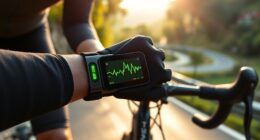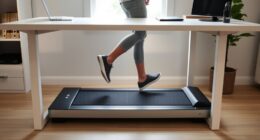In the realm of fitness, comparing bicycles and running is akin to weighing apples against oranges, each offering distinct advantages and trade-offs.
However, as we explore the nuances of these two popular forms of exercise, a deeper understanding emerges that goes beyond mere calorie burn and muscle engagement.
Let's uncover the intricacies that make the choice between cycling and running more than just a matter of personal preference or convenience, but a decision that could significantly impact our overall well-being and fitness journey.
Key Takeaways
- Running burns more calories per minute, aiding weight loss.
- Cycling can lead to higher overall calorie expenditure for extended durations.
- Running promotes bone density, while cycling offers joint-friendly exercise.
- Understanding muscle development and injury risks can optimize exercise choices.
Energy Expenditure Comparison
In comparing the energy expenditure of cycling and running, it's evident that both activities have distinct calorie-burning characteristics. Running, being a higher intensity activity, burns more calories per minute than cycling. However, cycling can lead to higher overall calorie expenditure due to its potential for longer durations of sustained effort. This difference makes cycling potentially more efficient for weight loss as it allows individuals to burn more calories over extended periods compared to running.
Both cycling and running are effective in improving fitness and metabolic outcomes. Consistency in engaging in either activity is vital for managing weight effectively. Moreover, the intensity at which these activities are performed also plays a crucial role in determining their impact on weight management. By adjusting the intensity levels, individuals can tailor their cycling or running routines to meet their specific weight loss or weight maintenance goals. Ultimately, both cycling and running offer valuable options for individuals seeking to enhance their fitness levels and manage their weight efficiently.
Impact on Muscle Development

Running and cycling impact muscle development differently due to their distinct muscle activation patterns and contraction types. When considering muscle development through exercise, it's essential to understand the unique impacts of running and cycling on muscle growth, recovery, and injury risk. Here are key points to consider:
- Muscle Activation: Running engages muscles in various ways, involving concentric, eccentric, and isometric contractions, promoting muscle damage and growth.
- Contraction Types: Cycling primarily activates muscles through concentric contractions, providing a different stimulus for muscle development compared to the multi-contraction nature of running.
- Recovery Time: Muscle recovery plays a crucial role in muscle development. Running's higher muscle damage may require longer recovery periods compared to cycling.
- Injury Risk: Running poses a higher risk of injury due to its impact on joints and muscles, which can affect long-term muscle development goals.
Understanding these factors can help individuals tailor their exercise routines to optimize muscle development while minimizing the risk of injury.
Bone Density Considerations

Considering the impact of weight-bearing exercises on bone health, such as cycling and running, is crucial for understanding bone density considerations. Running, being weight-bearing, is beneficial for maintaining bone density and strength.
In contrast, cycling, a non-weight-bearing exercise, doesn't significantly improve bone density. Individuals concerned about bone health should balance these activities or incorporate resistance training to promote bone density. Osteoporosis risk can be reduced by including running alongside cycling to prevent bone loss.
It's important to find a balance between exercises that strengthen bones and those that minimize joint impact for overall bone health. By incorporating a variety of exercises that include weight-bearing activities like running, individuals can work towards maintaining optimal bone density levels and reducing the risk of conditions like osteoporosis.
Regular assessment of bone density and consulting with healthcare professionals can guide individuals in making informed decisions about their exercise routines.
Cost and Convenience Analysis

To further explore the comparison between cycling and running, we shift our focus to analyzing the cost and convenience factors associated with these two forms of exercise.
- Running is a cost-effective option, requiring minimal equipment like running shoes.
- Quality cycling gear can be more expensive than essential running items.
- Maintenance and replacement costs for cycling equipment, such as bikes, can accumulate over time.
- Budget exercise bikes provide a more affordable indoor cycling alternative compared to treadmills, making indoor cycling cost-effective.
When considering convenience, running typically offers more accessible options, whether at the gym or outdoors, without the need for specialized trainers or routes. Cycling, on the other hand, may require investments in indoor trainers or finding suitable outdoor paths. Balancing cost-effectiveness and convenience is essential for those seeking an affordable and hassle-free exercise routine.
Health Benefits Overview

Engaging in either cycling or running provides individuals with significant cardiovascular benefits that enhance heart and lung health. While running engages more muscles, leading to a higher calorie burn rate and potential weight loss, cycling is a low-impact exercise that's gentler on the joints, making it suitable for individuals with joint issues.
Both activities help regulate blood pressure, blood sugar levels, and contribute to overall fitness. The calorie burn rate during cycling or running depends on factors like weight, metabolism, workout intensity, and duration. Cycling can be a preferred choice for those looking for a joint-friendly workout, while running offers a higher calorie burn and muscle engagement.
Regular participation in either activity can lead to improved cardiovascular health, increased endurance, and better overall fitness levels. It's essential to choose the exercise that aligns with personal goals, fitness levels, and physical condition to maximize the health benefits gained from cycling or running.
Frequently Asked Questions
Is Running or Biking Better to Lose Belly Fat?
For losing belly fat, both running and biking are effective. Consistent engagement in either activity creates a calorie deficit crucial for fat loss. Combining both in a workout routine can enhance results by targeting belly fat from various angles.
Does Biking Have the Same Effect as Running?
Biking delivers its own unique benefits, like a secret garden waiting to be discovered. Its effects differ from running but still lead to a path of fitness. Let's explore how biking can be a compelling alternative to running.
How Many Calories Do You Burn Running Vs Cycling?
We burn more calories running compared to cycling. Running torches about 566-839 calories per hour, while cycling burns around 488-738 calories. Factors like speed, weight, intensity, and terrain impact the calorie expenditure in these activities.
Is Running or Cycling Better for Mental Health?
Running and cycling both offer mental health benefits. Regular exercise in either form releases endorphins, improving mood and reducing stress. Each activity promotes mindfulness and clarity. Overall, both are excellent options for enhancing mental well-being.
Conclusion
In the race between the bicycle and running, each has its own strengths and weaknesses. Like gears shifting smoothly on a bike, we must tailor our exercise choice to align with our goals and needs.
Just as the wheels of a bike propel us forward, let's pedal towards optimal fitness and health by making informed decisions based on individual preferences and circumstances.
Let's keep moving forward, one revolution at a time.
















